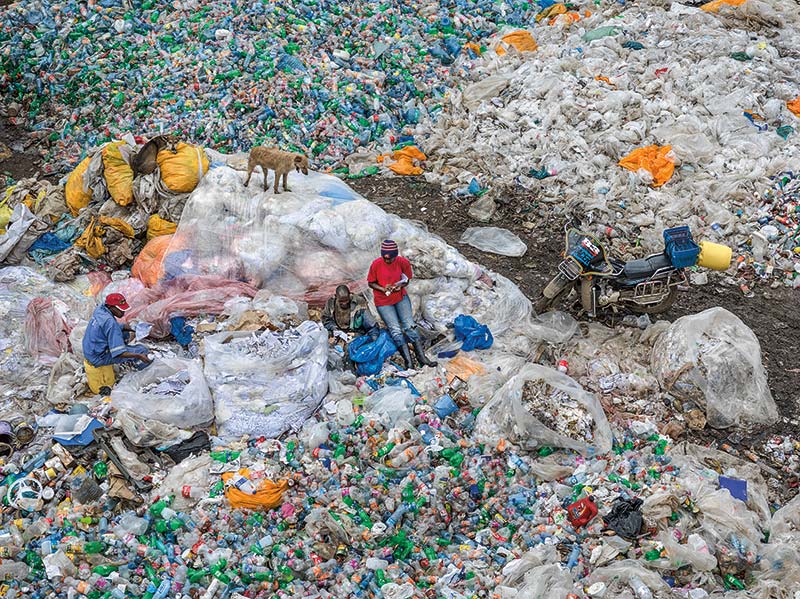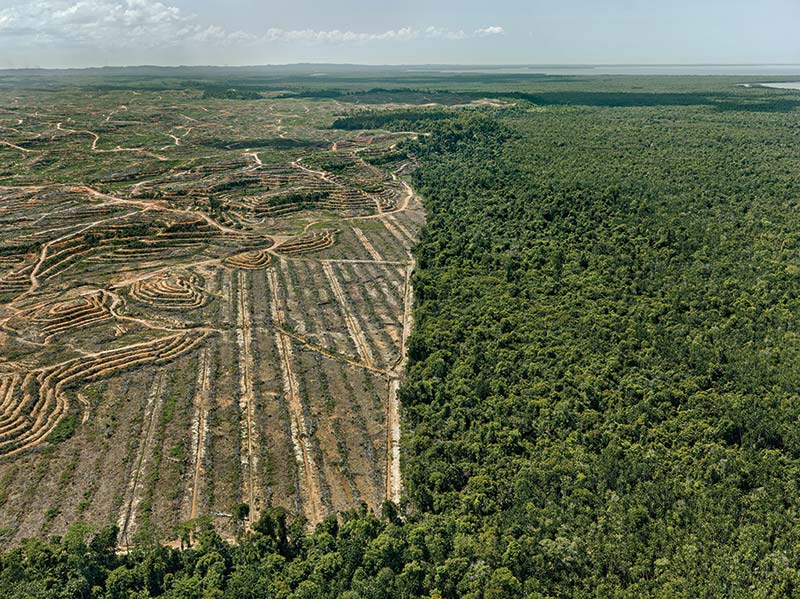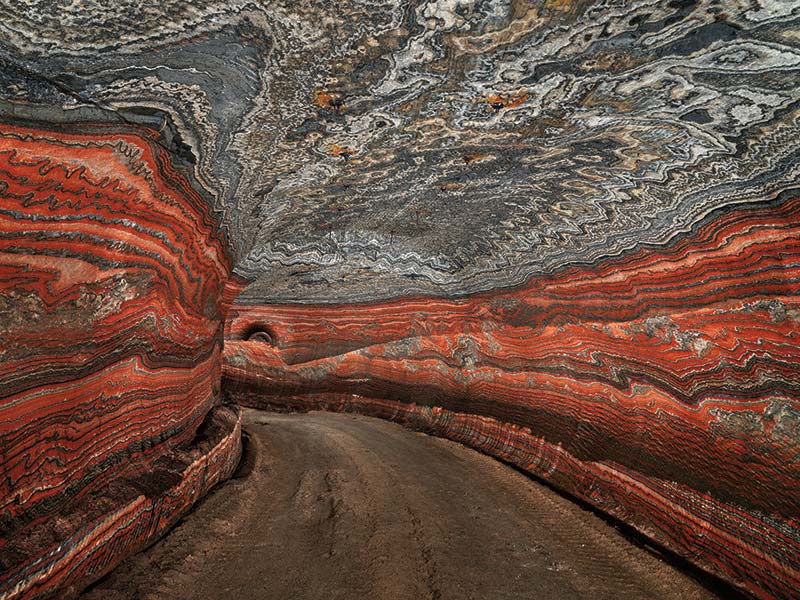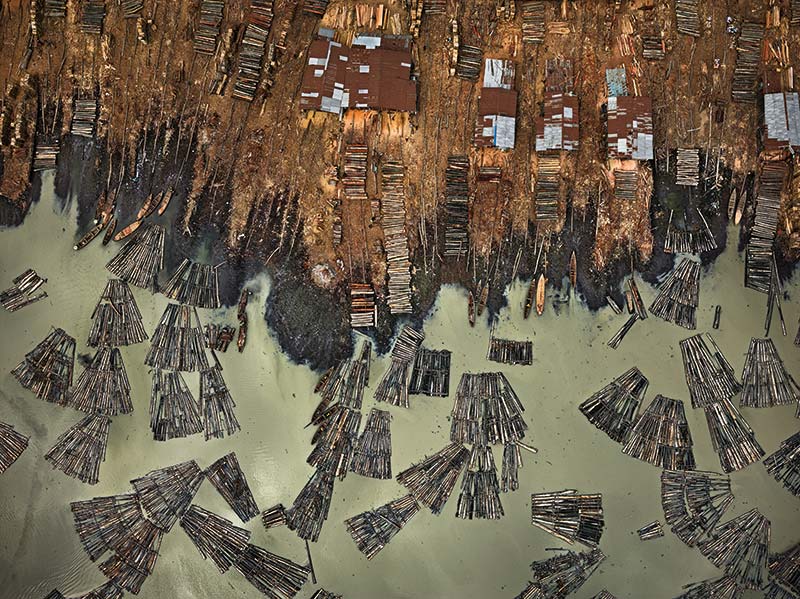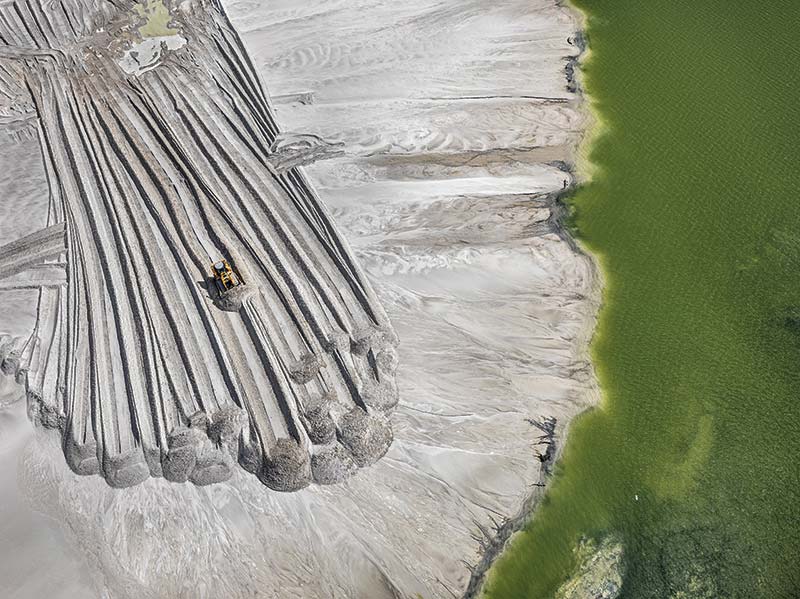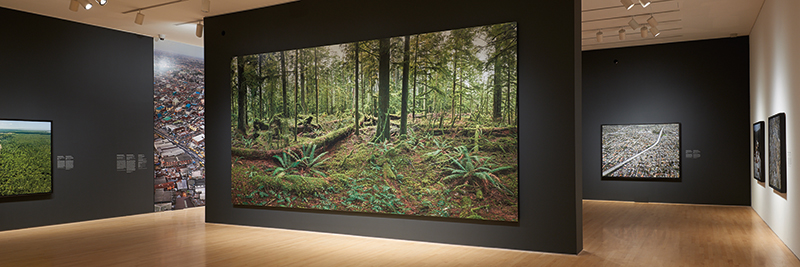[Summer 2019]
By Bénédicte Ramade
From the start it seems taken for granted: Edward Burtynsky’s Anthropocene at the National Gallery of Canada will be technophilic.1 At every opportunity. Even as stratigraphers are still discussing the contours of this geological epoch attributed to human activity, still bitterly arguing over the relevance of the very word “anthropocene” – as opposed to “capitalocene” or “plantationocene”2 – no debate stirs the exhibition spaces, which are dominated by outsized images and cinemascope projections that offer an unequivocal vision of the problem. Yet, the Anthropocene is not totally self-evident. Although the term first appeared in the pages of the venerable journal Nature in 20023, scientific consensus has not yet been reached. Still under discussion is the chronology of our era even as the markers confirming humans as a geological and atmospheric agent charged in the affair are being refined. Although the human presence on Earth has always had some effect – a consequence inherent to any biological agent – it is the first time that it has been regarded as being as powerful as a meteorite, capable of modifying Earth’s climate and structure in one fell swoop. We can presume that humanity did not do this intentionally – not early on, at least, as it is acting more and more like an irresponsible teenager, counting on its Earth-Mother to absorb the damage. The planet is resilient but, at this point, there’s no getting away from the fact that it can no longer compensate for all our mistakes.
Burtynsky has a perfect understanding of the power of the “Anthropocene”4 label; he has used it as a proven recipe for twin exhibitions, in Ottawa and Toronto, backed up by an eponymous film, which premièred with great pomp at the Toronto International Film Festival in September 2018. The film won the 2018 Rogers Award for Best Canadian Film (which Burtynsky received with Jennifer Baichwal and Nicholas de Pensier, with whom he has been working since his first film, Manufactured Landscapes, produced in 2006). Highlighting the same stylistic principles under this new rubric, Anthropocene: The Human Epoch is brimming with impressive aerial views showing the monstrous, systematic extractivism that is eating away at Earth’s crust at various locations around the globe, emphatically displaying traces of the mining industry’s abuses all over the world. For anyone who saw the film before visiting the exhibition, the latter proves redundant, a sort of freeze-frame on certain scenes, exaggeratedly enlarged – the biggest up to seven metres wide. Shown, in turn, are urban landscapes of the sprawling city of Lagos, a marble quarry at Carrara, clearcutting in the Borneo rainforest, and too many projections excerpted from the film itself.
The “value added” is composed of a digital tablet that can be borrowed from the institution if your smartphone isn’t technologically advanced enough to load the companion app to the exhibition, which offers augmented reality and virtual reality to reinforce the visual interpretation that Burtynsky and his partners provide of the Anthropocene. So, it’s a 2.0 era, which begins in the museum’s atrium in front of a column covered with photographic wallpaper bearing the image of bark – the bark of a Douglas fir 226 feet tall. The tablet displays an information tag on the specimen and activates the illusion that we are standing in front of the tree in its natural environment. This digital mediation puts us on our guard. Are we supposed to think that the device will emanate a sense of nature? That holding this object full of rare metals will make us more aware of the need to preserve the forests, or involve us physically? Would looking at a screen be more effective? The unease grows as we enter galleries that reveal Burtynsky paraphrasing himself, stamping the label “Anthropocene” on landscapes that resemble those in the Oil and Water series, terrifyingly aestheticized aerial views that make spectators feel guilty for admiring the unthinkable, the inordinate harnessing of terrestrial resources.
Can we still call upon the same visual means that haven’t changed since the rise of environmental photography in the 1970s?5 Are aerial views, over-accumulations of objects conveying overconsumption, the beauty of chemical pollution, skies saturated with harmful emissions – the triggering of a technological sublime – the only possible resources for visualizing the Anthropocene? Couldn’t we have invented something better? Experiencing the illusion of walking into a primeval forest or seeing a coral reef come alive in the bend of an immense photographic wall is what is offered by the advertised augmentation of reality. As for the virtual reality, after the introductory episode of the true-false tree trunk, it returns only in the epilogue of the exhibition visit, in a gallery dominated by a monumental geometric work by Minimalist master Sol Lewitt, in the form of two sculptures covered with black-and-white photographs. The objects are intriguing in themselves, and relatively successful because they are intriguing: they force us to become involved in the subject, to measure ourselves against a strange scale. The smaller one, perched on fragile glass pedestals, floating in front of the slightly dated mural by Lewitt, shows a piece of rough skin, reconstituted in close-up. Alas, the transition to virtual reality relies upon a gadget effect that seems simply to be satisfied with “prowess”: sloughing off the parallelepiped of white rhinoceros, through the tablet screen. Here again, the device is a flop. The physical proximity supposed to be transmitted by the process falls flat, and the transition between the “photographic reality” and the virtual doesn’t work. It’s a ploy, a trap that neutralizes Burtynsky’s technophilia and his idealized vision of environmental hell. Technology can do nothing here to rescue the images from their impotence.
According to Jerry Mander, who coined the term, “eco-porn”6 was a concept once likened to “greenwashing,” which Bart Welling described thus: “It masks sordid agendas with illusions of beauty and perfection.”7 That comes close to describing how Burtynsky anthropocenizes his photographic mannerisms. Although the definition of the term was refined, with the analysis by José Knighton and Lydia Millet, to designate images depicting a paradoxically intact nature, distancing it from Burtynsky’s paradigms of the sublime of destruction,8 Welling closely links eco-porn to technology. He refers to the ultra-technical nature of environmental images, their artificial dimension: “The fetishization of our technologies of seeing leads not to a critical introspection about the limits of human vision but to something like its opposite: an illusion both of solitary, unmediated experience and of complete visual power.”9 In fact, the technological argument, the shaping of Anthropocene, is found at the core of the museum’s communications, used as an irrefutable argument to qualify the pertinence of Burtynsky’s position. To this exaggerated technophilia that disembodies the subject, to the distance between the ground and the aerial point of view that reinforces physical withdrawal, is added the phenomenon of “catastrophe fatigue” analyzed by Norwegian psychologist Per Espen Stoknes, who explains, in effect, that we are no longer capable of assimilating the draped apocalyptic images in the current collapsologist discourse. In his view, geographic and temporal distance from the subject is the primary cause of disengagement, followed by fatigue in reaction to media strategies of collapse.
“The third point is ‘cognitive dissonance.’ When we know that the use of fossil fuels contributes to global warming, driving, eating steaks, or taking an airplane creates an inner malaise, which we try to dissipate by telling ourselves that our neighbour’s car pollutes more than ours. Then comes ‘denial’: we act as if we didn’t know, when we do know. Finally, the measures for struggling against warming sometimes come into conflict with our ‘identity.’ . . . Collapse porn is a fascination with the apocalypse that is exerted through videos, films, the media. All of this is based on standardized imagery, with columns of black smoke, streets full of cars, and melt- ing icebergs. . . . As we see more and more catastrophes, our mind gets habituated, fear and sense of guilt diminish, and in the end you don’t even pay attention anymore when they talk to you about the end of the world. So, you adopt a strategy of avoidance.”10
Anthropocene plays exactly on such parameters. The image of the last white rhinoceros, Sudan, who died in 2018, removing the possibility of perpetuating the species, is doubly distanced: already dead, and replayed by a digital avatar. The longest tunnel in the world, in Switzerland, the Dante-esque coal mines, in Rhineland, the pyres of elephant tusks, in Kenya – the world seems to be in total dere- liction, activating the visual rhetoric of catastrophe. But, as Paul Guillibert writes, “Apocalyptic narratives of the collapse to come and progressivist narratives of a modernity that is finally aware contribute, each in its own way, to perpetuating the mode of technical domination of nature. Indeed, they rest on a linear and teleological conception of history that leads to obliteration of the long history of struggles against technical development.”11 Burtynsky’s images therefore do not serve the cause in the right way. For more than forty years, similar visual strategies have proved incapable of actively raising the consciousness of spectators, saddling them with a certain defeatist passiveness instead of unleashing their agency. The Anthropocene cannot be satisfied with this type of omnipotent imagery that claims to circumscribe the subject in a single point of view and, especially, controls it technically thanks to shots from above. Sophie Hackett writes in the exhibition catalogue, “The view from above has been one predominant method for relaying these changes.”12 Again, the problem of distancing activates environ- mental fatigue – this distancing from Earth, where humanity lives and acts. Why is this distancing necessary; why do we need to look at it from so far away? Burtynsky’s eye is definitely not of this world: he offers a dated visual system, belonging to an inadequate strategy. The concepts of collapsology,13 positive catastrophism,14 and technosphere15 in no way respond to the need to view the Anthropocene in a different way, to invent, to imagine. On the contrary, they celebrate the omnipotence of destructive engineering. Photography of the technological sublime, as Burtynsky has been practising it since the early 1980s, does not respond to the needs of the Anthropocene but simply perpetuates the extractivist model. The very production of the images and the film, in fact, constitutes a disastrous ecological statement that will not be redeemed by simplistic carbon offsets. Environmental photography must reflect a different economy, a critical fragmentation that concretely conveys the geological era that we are now living in, or risk precipitating a terribly tragic Anthropocene fatigue. Translated by Käthe Roth
2 This concept was devised by Anna Lowenhaupt Tsing and taken up by Donna Haraway, who places the beginning of the current geological era in the sixteenth century with the establishment of sugar-cane plantations. See Anna Lowenhaupt Tsing, “A Feminist Approach to the Anthropocene,” public lecture, Barnard College, November 10, 2015; Donna Haraway, “Anthropocene, Capitalocene, Plantationocene, Chthulucene: Making Kin,” Environmental Humanities 6 (2015): 159–65.
3 Paul J. Crutzen, “Geology of Mankind,” Nature 415 (2002): 23, http://dx.doi.org/10.1038/415023a.
4 “What makes the Anthropocene an excellent marker, a ‘golden spike’ clearly detectable beyond the frontier of stratigraphy, is that the name of this geohistorical period may become the most pertinent philosophical, religious, anthropological, and . . . political concept for beginning to turn away for good from the notions of ‘Modern’ and ‘modernity,’” said Bruno Latour in his lecture “The Anthropocene and the Destruction of the Image of the Globe,” in Facing Gaia: Eight Lectures on the New Climatic Regime, trans. Catherine Porter (Cambridge, UK: Polity Press, 2017).
5 See Bénédicte Ramade, “From Nature to the Anthropocene: The Mutations of Environmental Photography,” in The Edge of the Earth: Climate Change in Photography and Video, ed. Bénédicte Ramade (London: Black Dog Publishing, 2018), 11–26.
6 Jerry Mander, “Ecopornography: One Year and Nearly a Billion Dollars Later, Advertising Owns Ecology,” Communication and Arts 14, 2 (1972): 45–56.
7 Bart Welling, “Ecoporn: On the Limits of Visualizing the Nonhuman,” in Ecosee: Image, Rhetoric, and Nature, ed. Sid I. Dobrin and Sean Morey (Albany: State University of New York, 2009), 55.
8 Ibid.
9 Ibid., 61.
10 Per Espen Stokes, interview with Nicolas Santolaria, “A force de voir des catastrophes, l’esprit s’habitue,” Le monde, October 21–22, 2018, “cahier idées,” 6 (our trans- lation).
11 Paul Guillibert, “L’effondrement, la catastrophe et la rédemption. Réflexions sur la crise écologique,” in De la catastrophe, ed. Michèle Riot-Sarcey (Paris: Éditions du Détour, 2018), 198 (our translation).
12 Sophie Hackett, “Far and Near: New Views of the Anthropocene,” in Anthropocene, ed. Sophie Hackett, Andrea Kunard, and Urs Stahel (Toronto and Fredericton, NB: Art Gallery of Ontario and Goose Lane Editions, 2018), 16.
13 This concept devised by Pablo Servigne and Raphael Stevens, published in Comment tout peut s’effondrer: Petit manuel de collapsologie à l’usage des générations présentes (Paris: Seuil, 2015), probes the history of collapses.
14 Pablo Servigne developed this positive and regenerative vision of collapse, which goes beyond the negative effects of environmental apocalypse.
15 Colin Water and Jan Zalasiewicz,“The Anthropocene and its ‘Golden Spike,’” in Anthropocene, ed. Sophie Hackett, Andrea Kunard, and Urs Stahel (Toronto and Fredericton, NB: Art Gallery of Ontario and Goose Lane Editions, 2018), 40.
Bénédicte Ramade is an art critic and historian of modern and contemporary art, specializiing in environmental issues. She has organized exhibitions and accompanying catalogues, including The Edge of Earth: Climate Change in Photography and Video at the Ryerson Image Centre in Toronto, in 2016, and Karine Payette at the Maison des arts de Laval, in February–April 2019. She published “La photographie en elle-même” in the first monograph devoted to Yann Pocreau, Sur les lieux/On site (Musée d’art des Laurentides and Expression). She is a lecturer in the art history and film studies department at the Université de Montréal and at the visual and media arts school at UQAM.

